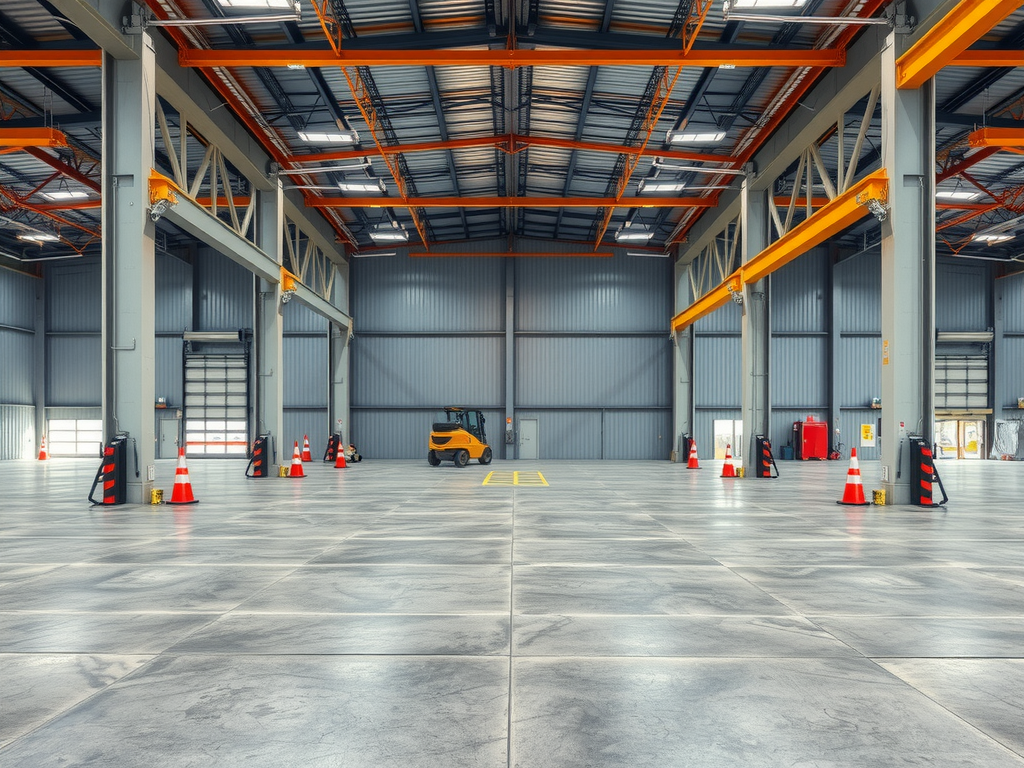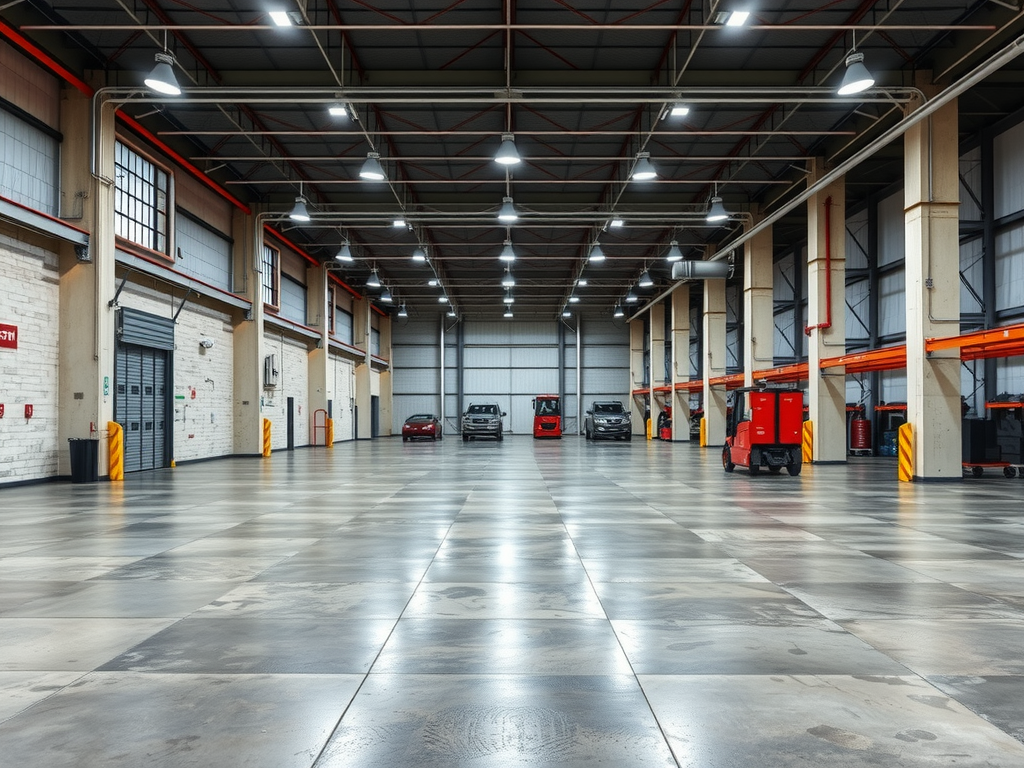
Amarillo businesses are revolutionizing their workspaces through cutting-edge flooring technologies. Companies across the city are turning to advanced resurfacing techniques, including epoxy applications, polyurea treatments, and polyaspartic installations, to rejuvenate their industrial environments.
These innovative solutions offer exceptional durability and longevity, meeting the demanding durable coatings requirements of manufacturing and storage facilities.
The implementation of these state-of-the-art flooring systems enhances workplace safety, elevates professional appearances, and significantly boosts operational efficiency.
- Slip-resistant surfaces improve employee safety
- Upgraded aesthetics create a more professional environment
- Seamless, easy-to-clean floors increase productivity
Customizable flooring options cater to various industrial sectors, from production plants to distribution centers. The seamless surfaces provided by these solutions offer long-term economic benefits through reduced maintenance costs and extended floor life. Companies investing in these advanced flooring systems chemical resistance are effectively optimizing their operations and safeguarding their physical assets for years to come.
Click here to learn more about: amarilloepoxyservices.com
Durable Coatings For Industrial Floors
Robust flooring solutions are paramount for environments that face constant wear and tear. Epoxy coatings have become the go-to choice for protecting and enhancing surfaces in high-traffic areas.
These innovative solutions offer exceptional resistance to chemicals, impacts, and heavy use, making them ideal for manufacturing facilities, warehouses, and commercial kitchens.
Epoxy flooring provides a seamless, moisture-resistant surface while contributing to a safer work environment with its non-slip properties.
The versatility of these coatings allows for customization in color and finish, meeting both functional and aesthetic requirements of various industrial spaces.
- Chemical resistance: Epoxy flooring repels oils, solvents, and other corrosive substances commonly found in industrial settings.
- Easy maintenance: The smooth, nonporous surface simplifies cleaning and reduces maintenance time and costs.
- Durability: These floors can withstand heavy machinery, frequent foot traffic, and impact from dropped tools or equipment.
Alternative durable coatings like polyurea and polyaspartic offer unique advantages for specific applications. Polyurea coatings provide rapid curing times and excellent elasticity, suitable for areas subject to movement or vibration. Polyaspartic coatings offer UV stability and quick installation, ideal for time-sensitive projects or outdoor industrial spaces.
The installation process involves thorough surface preparation, application of the chosen coating, and proper curing time. Factors to consider when selecting the right solution include:.
- Specific environmental conditions
- Expected traffic and load-bearing requirements
- Chemical exposure risks
- Desired aesthetics and safety features
Investing in durable coatings for industrial floors offers long-term value and significant return on investment. The extended lifespan of these solutions, coupled with reduced maintenance needs, translates to cost savings over time. The improved safety and aesthetics can contribute to increased productivity and a more positive work environment.

Why Choose Epoxy Flooring?
Seamless Surfaces In Commercial Kitchens
Epoxy flooring transforms culinary workspaces, elevating hygiene standards and operational efficiency. This innovative solution, akin to those utilized in hospitals, provides a range of benefits for busy food preparation environments.
- Sanitation and Hygiene:
- Nonporous surfaces prevent bacterial growth and food particle accumulation.
- Seamless design eliminates hiding spots for contaminants.
- Durability and Maintenance:
- Floors withstand heavy traffic and equipment movement in commercial kitchens.
- Quick cleaning reduces maintenance time and costs, similar to aircraft hangars.
- Safety Features:
- Slip-resistant additives enhance traction in wet areas.
- Continuous surface reduces trip hazards for kitchen staff.
- Customization Options:
- Color-coding improves workflow and organization in food service areas.
- Unique designs can be implemented to match brand aesthetics.
Epoxy surfaces in commercial kitchens offer a practical, hygienic, and customizable flooring solution that enhances food safety and operational efficiency. These qualities make epoxy an excellent choice for culinary environments, schools, and other high-traffic areas requiring pristine conditions.
Slip-Resistant Finishes For Safety
Commercial kitchens demand effective measures to prevent accidents and reduce liability. Epoxy flooring with textured finishes offers a reliable solution to this challenge.
The incorporation of aggregate additives enhances traction in wet areas, making industrial-grade sealants an excellent choice for high-traffic zones.
Application techniques, such as the broadcast method, ensure even distribution of non-slip materials throughout the surface.
Customizable texture levels allow for tailored solutions in different kitchen areas, addressing specific needs for each zone. Regular maintenance, including proper cleaning procedures and periodic resurfacing, is crucial for preserving the effectiveness of these safety features.
Substrate preparation plays a vital role in ensuring the longevity and performance of slip-resistant surfaces. Joint filling and crack repair further contribute to the overall durability of the flooring system.
These measures not only protect kitchen staff but also extend to other areas such as sports complexes, where safety is equally important.
The seamless transition from kitchen surfaces to other commercial spaces ensures consistent protection throughout the facility.
| Epoxy Flooring Benefits | Safety Measures |
|---|---|
| Enhanced traction in wet areas | Textured finishes for slip resistance |
| Customizable texture levels | Even distribution of non-slip materials |
| Durability in high-traffic zones | Regular maintenance and resurfacing |
Amarillo’s Epoxy Flooring Cost Estimates
Polyurea Vs Polyaspartic: Which Works Best?
Flooring professionals often debate the merits of advanced coating solutions. Polyurea and polyaspartic materials represent cutting-edge options in the industry, each offering unique benefits for specific applications.
Careful analysis of project requirements helps determine the most suitable choice.
- Curing Times:
- Polyurea: Solidifies swiftly, typically within hours, enabling rapid project completion and custom color blends
- Polyaspartic: Sets quickly, allowing use in approximately 24 hours, reducing downtime and supporting flake systems
- Durability:
- Polyurea: Exhibits remarkable impact and abrasion resistance, suitable for demanding environments and quartz broadcast applications
- Polyaspartic: Demonstrates excellent chemical and UV resistance, preserving appearance and allowing terrazzo-like finishes
- Best Applications:
- Polyurea: Thrives in industrial settings with high wear and tear, offering low VOC solutions
- Polyaspartic: Excels on garage floors and outdoor surfaces exposed to sunlight, supporting metallic pigments
- Application Process:
- Polyurea: Demands specialized equipment and professional application techniques
- Polyaspartic: Applicable with standard tools, making it more accessible for do-it-yourself projects
Temperature sensitivity during application plays a significant role for both coatings. Long-term maintenance requirements should also factor into the decision between polyurea and polyaspartic options. These eco-conscious materials provide robust, low-maintenance solutions for diverse flooring needs.
Resinous Flooring For High-Traffic Areas
Durability remains a top priority for businesses and facilities dealing with constant foot traffic and equipment movement. Robust solutions offer exceptional resilience in high-stress environments, addressing these challenges effectively.
Epoxy flooring excels in withstanding heavy loads and frequent use, making it an ideal choice for industrial settings and commercial spaces alike.
High-solids epoxies form a formidable barrier against wear and tear, effectively resisting impacts from heavy machinery and foot traffic.
These specialized coatings create a seamless surface that protects the underlying concrete while enhancing safety with slip-resistant properties. The addition of nonslip aggregates further improves traction, reducing accident risks in busy areas.
Several advantages make resinous flooring systems ideal for high-traffic zones:
- Enhanced durability and longevity
- Improved safety features
- Easy maintenance and cleaning
- Cost-effectiveness over time
When selecting flooring for high-traffic areas, consider specific traffic patterns, load requirements, and environmental conditions. Moisture levels and chemical exposure can impact the performance of certain coatings, necessitating the use of specialized formulations or hybrid polymer systems in some cases.
Aesthetic considerations should also factor into the decision-making process, as resinous flooring can be customized to complement various settings.
To ensure the longevity of resinous flooring in high-traffic areas, implement a regular maintenance routine. This should include daily cleaning, prompt addressing of minor damages, and periodic professional inspections. By following these steps, facilities can maximize the lifespan of their flooring investment and maintain a safe, attractive environment for years to come.
While polyurea and polyaspartic coatings offer unique benefits, epoxy remains a popular choice for its durability and versatility. The installation process for epoxy flooring varies depending on the specific project requirements and environmental factors.
How Long Does Epoxy Installation Take?
Resinous flooring projects require careful planning and execution to achieve optimal results. The duration of an installation varies based on several factors, including project scope and environmental conditions.
Typically, the process spans 3 to 7 days, encompassing multiple stages:.
- Surface Preparation (1-2 days):
- Thorough cleaning and repairing of the concrete surface
- Moisture testing and application of primer
- Epoxy Application (1-2 days):
- Base coat application
- Optional decorative elements (chips, flakes, or metallic pigments)
- Top coat application
- Curing Time (1-3 days):
- Initial set time: 24-48 hours for light foot traffic
- Full cure: 3-7 days for heavy traffic and chemical resistance
Project complexity and size significantly impact the overall installation timeline. Professional installers can efficiently manage the process, ensuring polished concrete results and maximizing the longevity of your new floor. While high-traffic areas benefit from resinous flooring, proper installation time is necessary for durability.
Resinous Flooring Installation
- Installation typically takes 3 to 7 days, depending on project scope and conditions
- Surface preparation is crucial and can take 1-2 days to ensure proper adhesion
- Epoxy application involves multiple layers, including base coat and optional decorative elements
- Full curing time can take up to 7 days for heavy traffic and chemical resistance
